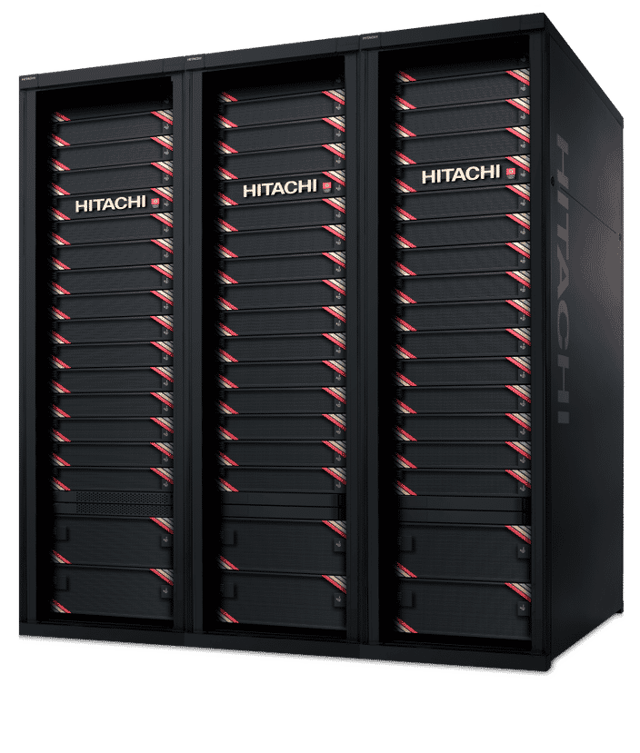
Hitachi Vantara Eyes Hybrid Clouds with New Storage Offerings
The new lineup aims to give large enterprises and SMEs the ability to stretch their cloud environments from data centers to the edge.

Hitachi Vantara continues to position its broad storage portfolio to address the evolving demands of enterprises adopting hybrid cloud environments and want to ensure that cloud-like capabilities extend into their on-premises data centers.
The company this week introduced a host of new and enhanced offerings touching on storage virtualization, hybrid cloud infrastructure, and data migration to give large enterprises and SMEs what they need to stretch their cloud environments from their data centers to the edge, manage the massive amounts of data they’re generating and run modern workloads like artificial intelligence (AI) and cloud-native applications.
Organizations are continuing to move more of their workloads and data into the cloud, but most have come to understand that not all of their business can be based in the cloud, Radhika Krishnan, Hitachi Vantara’s chief product officer, told Enterprise Storage Forum.
“It’s going to be some form of hybrid and how much of it resides on-prem vs. how much of it lives in the cloud comes down to the kind of workloads and how aggressively they’re investing in going cloud-native and so on,” Krishnan said. “That being said, we see the need to be much more of a hybrid cloud in terms of things such as data mobility.”
Also read: Best Hybrid Cloud Storage Vendors & Software 2021
Various reports have shown that organizations are bending hard toward hybrid clouds. According to IT management solutions vendor Flexera’s 2021 State of the Cloud report, 80 percent of enterprises have hybrid cloud strategies in place and 92 percent are going multicloud.
There are a number of factors in play, Krishnan said. The issue of data gravity — situating data closer to applications to reduce latency and improve responsiveness — is increasingly important to organizations, she said. In addition, IT budgets are shifting from CapEx to OpEx models, driven in large part by the adoption of per-usage base consumption models of most IT hardware and software.
“The cloud has essentially introduced that and it’s almost becoming the norm to be able to offer customers a way to consume infrastructure as a utility or in that consumption model,” Krishnan said.
Infrastructure resiliency and control also are issues for organizations, which worry that if something goes awry in the cloud and workloads go down, they don’t have control over the situation. Hitachi Vantara is moving aggressively on a number of fronts to address these wide-ranging concerns, she said.
“The reality is that customer needs in terms of these aspects around resiliency, around data gathering, data portability and stuff become very critical,” Krishnan said. “We’re honing in on these and we’re driving innovation that much harder, which is what is allowing us to deliver this very broad set of capabilities.”
Hitachi Vantara rolled out new versions of its Virtual Storage Platform (VSP) E590 and E790 systems for small and midsize enterprises (SMEs) that may want to consolidate diverse workloads onto a single platform. Organizations can choose from all-NVMe or all-SAS or a combination of both. By extending SAS to these systems, Hitachi Vantara is aiming to meet low-latency requirements and affordability that SMEs demand.
“We’re now saying customers can take advantage of SAS as well” as NVMe, she said. “They can go all-SAS, all-NVMe or they can have a hybrid of the two. This all comes down to the workload at the end of the day and the latency requirements coming off of it.”
The new versions are part of the vendor’s hybrid cloud data virtualization efforts and include having common data services and virtualization for its software-defined and hosted cloud offerings.
Hitachi Vantara also is integrating the solutions with Google Cloud’s Anthos offering, which enables organizations to run their cloud services on premises, at the edge or in multiple public clouds — part of a larger trend among public cloud providers like Amazon Web Services (AWS) and Microsoft Azure to make their services available in all environments and on various cloud platforms — and Red Hat’s OpenShift Kubernetes platform.
There also is Hitachi Vantara’s Replication Plug-In for Containers, providing data services in containers for stateful storage in the vendor’s VSP and E-Series products.
Hitachi Vantara also is bringing new models to its VSP 5000 Series scale-out data platform. The VSP 5200 and 5600 increases the usability capacity and delivers 42 percent performance improvement in data reduction and includes end-to-end NVMe in the 5600, which delivers 33 million IOPS of performance and as low as 39 microseconds of latency.
Pushing for cloud-like agility and scalability on premises, the vendor is offering a “data in place” upgrade path to the new VSP 5000 Series solutions and its Hitachi Modern Storage Assurance for a simpler procurement process. Enterprises can include the assurance program in the cost of the new VSP 5200 or 5600 solutions or as part of Hitachi Vantara’s EverFlex as-a-service offerings, enabling enterprises to acquire hardware, software and services via a pay-per-use model.
Dell Technologies, Lenovo, Cisco Systems and Hewlett Packard Enterprise are among the growing list of traditional hardware vendors that are increasingly offering more of their product portfolios as a service, similar to what Hitachi Vantara is doing with EverFlex.
New optimization settings that more efficiently distribute objects across the architecture is enabling the Hitachi Content Platform (HCP) object storage offering to provide twice the performance for cloud apps than previous generations. HCP comes with a new scale-out policy engine that includes data services that can be customized to a use case or workload.
In addition, Hitachi Content Software for File now supports data ingested from Amazon’s S3 object storage for such high-performance applications as Internet of Things (IoT) sensors and video surveillance systems that rapidly feed large amounts of data into a central repository.
The vendor’s Hitachi Ops Center is a cloud-based health monitoring system that uses AI and machine learning techniques for reporting, improving performance and data management for distributed teams. It now includes integrated real-time analytics and automation capabilities that reduce manual storage management tasks by up to 70 percent and enables organizations to get to root cause analysis up to four times faster, according to the company.
Read next: Mapping Out a Hybrid Multicloud Strategy

Jeffrey Burt has been a journalist for more than three decades, the last 20-plus years covering technology. During more than 16 years with eWEEK, he covered everything from data center infrastructure and collaboration technology to AI, cloud, quantum computing and cybersecurity. A freelance journalist since 2017, his articles have appeared on such sites as eWEEK, The Next Platform, ITPro Today, Channel Futures, Channelnomics, SecurityNow, Data Breach Today, InternetNews and eSecurity Planet.

Enterprise Storage Forum offers practical information on data storage and protection from several different perspectives: hardware, software, on-premises services and cloud services. It also includes storage security and deep looks into various storage technologies, including object storage and modern parallel file systems. ESF is an ideal website for enterprise storage admins, CTOs and storage architects to reference in order to stay informed about the latest products, services and trends in the storage industry.
Property of TechnologyAdvice. © 2025 TechnologyAdvice. All Rights Reserved
Advertiser Disclosure: Some of the products that appear on this site are from companies from which TechnologyAdvice receives compensation. This compensation may impact how and where products appear on this site including, for example, the order in which they appear. TechnologyAdvice does not include all companies or all types of products available in the marketplace.